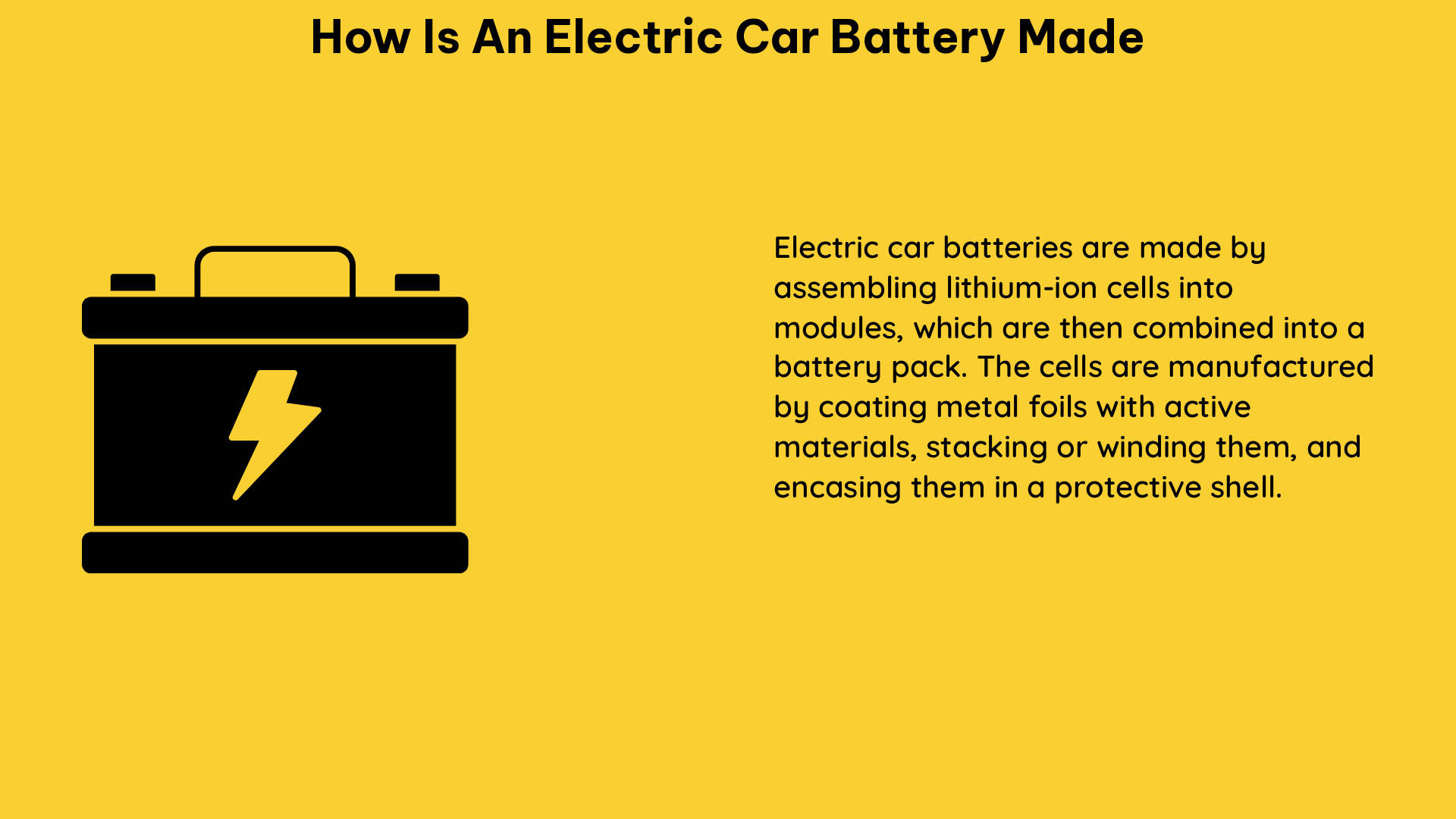The production of an electric car battery is a complex and intricate process that involves several stages and materials. The most common type of battery used in electric vehicles (EVs) is the lithium-ion battery, which consists of a cathode, an anode, an electrolyte, and a separator.
Cathode Composition
The cathode is typically made of one of the following materials:
- Lithium Nickel Manganese Cobalt Oxide (LiNiMnCoO2): This cathode material offers a good balance of energy density, power density, and safety.
- Lithium Cobalt Oxide (LiCoO2): This cathode material has a high energy density but lower thermal stability and safety compared to other options.
- Lithium Iron Phosphate (LiFePO4): This cathode material has a lower energy density but higher thermal stability and safety, making it a popular choice for some EV models.
The choice of cathode material is a crucial factor in determining the overall performance and characteristics of the battery.
Anode Composition

The anode is typically made of graphite, which is a form of carbon. Graphite provides a stable and efficient platform for the intercalation and deintercalation of lithium ions during the charging and discharging process.
Electrolyte Composition
The electrolyte is a lithium salt, such as lithium hexafluorophosphate (LiPF6), dissolved in a liquid or gel-like organic solvent. The electrolyte facilitates the movement of lithium ions between the anode and cathode during the battery’s operation.
Separator
The separator is a porous membrane that physically separates the anode and cathode, preventing them from coming into direct contact while allowing the flow of lithium ions between them. This is a critical component for ensuring the safety and stability of the battery.
Battery Cell Manufacturing Process
The manufacturing process of lithium-ion battery cells for electric vehicles typically involves the following steps:
- Electrode Preparation: The cathode and anode materials are coated onto thin metal foils (typically aluminum for the cathode and copper for the anode) to create the electrode sheets.
- Electrode Cutting and Stacking: The electrode sheets are cut into the desired shape and size, then stacked with the separator material in between to form the battery cell.
- Electrolyte Filling: The battery cell is filled with the liquid or gel-like electrolyte solution.
- Cell Sealing: The battery cell is sealed to prevent the electrolyte from leaking and to protect the internal components from the external environment.
- Formation and Aging: The battery cell undergoes a formation process, where it is charged and discharged multiple times to activate the electrodes and stabilize the internal chemistry. This is followed by an aging process to further improve the cell’s performance and safety.
- Module and Pack Assembly: The individual battery cells are assembled into modules, which are then combined to form the complete battery pack for the electric vehicle.
Environmental Considerations
The production of electric car batteries can have significant environmental impacts, particularly in terms of greenhouse gas emissions and the use of natural resources. Some key considerations include:
- Raw Material Extraction: The mining and processing of raw materials like lithium, cobalt, and nickel can be energy-intensive and have a high carbon footprint. For example, the extraction of 1 tonne of lithium can result in the emission of 15 tonnes of CO2.
- Manufacturing Process: The high-temperature synthesis of battery materials and the assembly of battery cells require large amounts of energy, often generated from fossil fuels, contributing to the overall carbon footprint of the battery production process.
- Geographical Factors: The majority of lithium-ion batteries are currently manufactured in China, where the primary energy source is coal, further exacerbating the environmental impact.
Despite these challenges, the use of electric vehicles charged with renewable energy sources can still result in significant reductions in greenhouse gas emissions over the lifetime of the vehicle compared to traditional gasoline-powered cars.
Conclusion
The production of electric car batteries is a complex and multifaceted process that involves the careful selection and integration of various materials and components. While the environmental impact of battery manufacturing is a concern, the overall benefits of electric vehicles in terms of reduced emissions and improved sustainability make them a crucial technology in the transition towards a more sustainable transportation future.
References
- Wassiliadis, N., Steinsträter, M., Schreiber, M., Rosner, M., Nicoletti, L., Schmid, F., Ank, M., Teichert, M., Wildfeuer, O., Schneider, L., Koch, J., König, A., Glatz, A., Gandlgruber, A., Kröger, J., Lin, T., Lienkamp, M. (2022). Quantifying the state of the art of electric powertrains in battery electric vehicles: Range, efficiency, and lifetime from component to system level of the Volkswagen ID.3. Journal of Power Sources, 499, 229212.
- Zhao, J., Burke, A.F. (2022). Electric Vehicle Batteries: Status and Perspectives of Data-Driven Diagnosis and Prognosis. Batteries, 8(10), 142.
- Emilsson, E., Dahllöf, L. (2019). Lithium-ion vehicle battery production: Status 2019 on energy use, CO2 emissions, use of metals, products environmental footprint, and recycling. IVL Swedish Environmental Research Institute, in cooperation with the Swedish Energy Agency, Report C444.
- Hall, D., Lutsey, N. (2018). Effects of battery manufacturing on electric vehicle life-cycle greenhouse gas emissions. The International Council on Clean Transportation.

The lambdageeks.com Core SME Team is a group of experienced subject matter experts from diverse scientific and technical fields including Physics, Chemistry, Technology,Electronics & Electrical Engineering, Automotive, Mechanical Engineering. Our team collaborates to create high-quality, well-researched articles on a wide range of science and technology topics for the lambdageeks.com website.
All Our Senior SME are having more than 7 Years of experience in the respective fields . They are either Working Industry Professionals or assocaited With different Universities. Refer Our Authors Page to get to know About our Core SMEs.